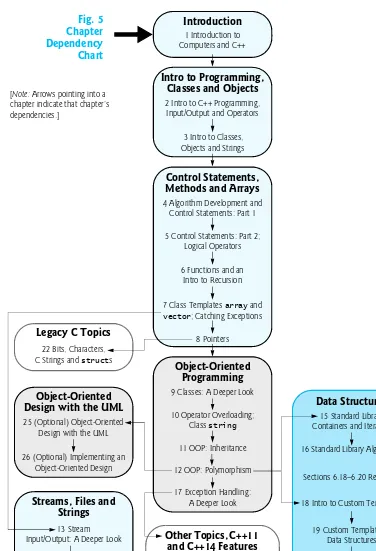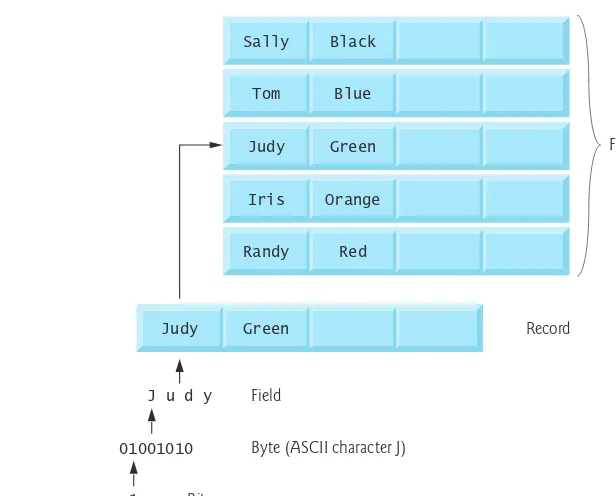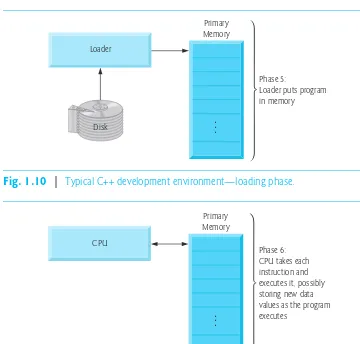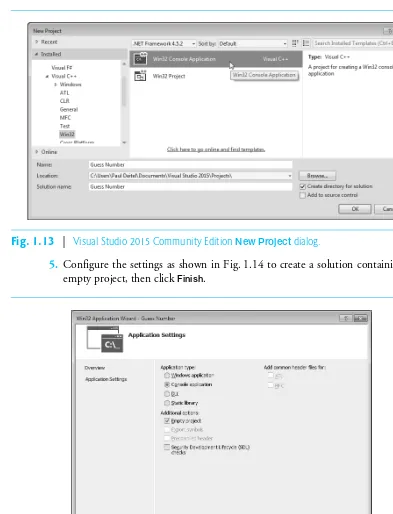I. Introduction to Computers and C++
This introductory chapter lays the groundwork for the entire textbook, establishing fundamental concepts related to computer science and the C++ programming language. It begins with a broad overview of computer hardware and software, emphasizing Moore's Law and the hierarchical structure of data. The chapter then delves into the evolution of programming languages, from machine languages and assembly languages to high-level languages like C and C++. A significant portion is dedicated to introducing object technology and its importance in modern software development. This section highlights the core principles of object-oriented programming (OOP) which are thoroughly explored in later chapters. The chapter concludes by providing practical guidance on setting up a C++ development environment across different operating systems (Windows, Linux, macOS), including detailed instructions on compiling and running a basic C++ application using various compilers like Visual Studio, GCC, and Xcode. This hands-on approach immediately engages the learner with practical application of the concepts. The pedagogical value of this chapter lies in its ability to bridge the gap between abstract concepts and practical implementation, making it accessible to students with varying levels of programming experience.
1.1 Introduction
This section provides a brief welcome to the field of computer programming and introduces the overall scope and purpose of the textbook. It sets the tone for the rest of the book, emphasizing the live-code approach and the importance of practical application throughout the learning process. This section serves as a vital engagement tool to students, drawing their attention and interest from the initial pages itself.
1.2 Computers and the Internet in Industry and Research
This subsection explores the ubiquitous presence of computers and the internet in various industries and research domains. It highlights the transformative impact of these technologies across diverse sectors, providing real-world context to the subject matter. The inclusion of relevant industry examples and applications makes the learning material more relatable and intellectually stimulating for the students.
1.3 Hardware and Software
This section delves into a fundamental overview of computer hardware and software. It touches upon crucial concepts like Moore’s Law, which dictates the exponential growth in computing power, and the overall organization of a computer system. The discussion extends to the interplay between these two pivotal aspects of computing, explaining their interconnectedness and mutual dependence in running any program. This forms a solid foundation for subsequent chapters that introduce programming concepts.
1.4 Data Hierarchy
The data hierarchy section provides an explanation of how data is organized in a computer system from bits to files. This fundamental understanding is crucial for comprehending how data is stored, processed, and managed within a computer, underpinning many advanced concepts presented later in the book. The presentation of this topic likely includes visuals such as diagrams to illustrate the layered structure of the data hierarchy, reinforcing comprehension. This is a vital aspect for the development of the student's knowledge.
1.5 Machine Languages, Assembly Languages, and High-Level Languages
This section traces the historical development of programming languages, moving from low-level machine languages, through assembly languages, to the more abstract high-level languages used in modern software development. This historical perspective illustrates the evolution of programming paradigms and the increasing level of abstraction achieved through each successive language generation. It's a crucial part to understanding the context of C++'s place in the larger programming landscape.
1.6 C and C++
This subsection focuses on the relationship between C and C++, highlighting C++'s origins as an extension of C and exploring the key features that distinguish it as an object-oriented language. The historical context provided clarifies the evolution of C++ and the rationale behind its design choices. This will help students understand the power and flexibility of C++.
1.7 Programming Languages
This section gives a broader overview of various types of programming paradigms and languages, enriching student's perspective beyond the specific C++ focus of the textbook. This serves to emphasize C++'s place among the diverse landscape of available tools, enhancing their understanding of the trade-offs and strengths of each approach. The inclusion of broader concepts here helps students in selecting the right tool for the right task.
1.8 Introduction to Object Technology
This is a crucial section introducing the fundamental principles of object-oriented programming (OOP). It presents concepts such as classes, objects, and methods, providing a high-level overview of the OOP paradigm that serves as a foundation for more detailed treatments in subsequent chapters. The use of illustrations and examples will make it much easier to understand for those without programming experience.
1.9 Typical C++ Development Environment
This section provides a practical guide to setting up a C++ development environment. It walks the reader through the process of installing necessary software, configuring compilers, and familiarizing themselves with the basic tools of the trade. This will be very useful to students who will require a step-by-step guide to install the required software. This is where the student will have to take the first steps in learning C++.
1.10 Test-Driving a C++ Application
This section guides students through their first C++ program, emphasizing a hands-on approach. It provides detailed, platform-specific instructions on compiling and running a sample application using different compilers (Visual Studio, GCC, Xcode) for different operating systems (Windows, Linux, macOS). This immediate practical experience reinforces concepts learned earlier and sets the stage for further coding throughout the textbook. This allows for the students to test their knowledge and reinforce what they have learned.
1.11 Operating Systems
A brief overview of different operating systems (Windows, Linux, macOS, Android) is presented, providing context for the environment in which C++ programs typically run. This contextual information helps students understand the relationship between the software they will be developing and the underlying operating system that manages it. The context is a valuable addition to student's knowledge.
1.12 The Internet and the World Wide Web
This subsection provides a brief overview of the internet and the World Wide Web, providing further context for the broader applications of the software development skills being taught. It emphasizes the pervasive nature of network technologies, highlighting the importance of software development in this connected world. The students will need to understand the place of the internet and its role in the future of programming.
1.13 Some Key Software Development Terminology
This section introduces key terminology and concepts used in software development. This serves as a glossary of essential terms, ensuring that students are familiar with the technical language used throughout the rest of the book. The glossary section will be very useful to those who require a refresher on some of the key terms that they will use during the rest of their learning.
1.14 C++11 and C++14: The Latest C++ Versions
The chapter briefly introduces the newer C++11 and C++14 standards, preparing the student for features introduced throughout the book. This sets the stage for the incorporation of modern C++ features and practices in subsequent chapters, ensuring the material remains current and relevant. This ensures that the student's knowledge of C++ is up to date.
1.15 Boost C++ Libraries
A brief overview of Boost C++ libraries is given, hinting at the extensive ecosystem of tools and resources available to C++ developers. This brief introduction to Boost prepares the students for more advanced concepts and the utilization of external resources that help improve programming efficiency. It emphasizes that programming is a community effort.
1.16 Keeping Up to Date with Information Technologies
This concluding section emphasizes the importance of continuous learning and staying updated in the rapidly evolving field of information technology. This final message underscores the dynamic nature of the field and encourages learners to adopt a proactive approach to professional development, promoting lifelong learning. This important message is valuable for all students.
II. Introduction to C++ Programming, Input/Output, and Operators
Chapter 2 dives into the core syntax and mechanics of C++ programming. It introduces fundamental concepts like printing text to the console, performing arithmetic operations, and using operators. This chapter is designed to provide a basic understanding of the core programming concepts before moving onto the more advanced topics presented in later chapters. The chapter progresses by demonstrating the concept of memory management, which is essential for any type of programming. The chapter then covers decision-making structures using comparison operators. Throughout the chapter, the authors likely use short, self-contained programs to illustrate the concepts, helping to foster understanding before moving on to larger projects. The chapter's pedagogical value lies in introducing fundamental programming constructs in an accessible manner, ensuring a strong base for the more advanced concepts discussed in subsequent chapters.
2.1 Introduction
A brief introduction to the chapter's purpose and content, setting the stage for the topics that will be covered. This sets the context for the rest of the chapter and will give the students an idea of what to expect.
2.2 First Program in C++: Printing a Line of Text
This section presents the classic "Hello, World!" program to initiate students' interaction with the C++ language. This is a fundamental and effective way of getting new programmers to start coding in C++.
2.3 Modifying Our First C++ Program
Here, the initial program is modified to demonstrate basic input and output operations, introducing the concept of taking user input and displaying results. This is a useful way to introduce new topics and concepts by working with examples from previous sections.
2.4 Another C++ Program: Adding Integers
This builds upon the previous section by demonstrating a more complex program that performs arithmetic operations on user-supplied input. This will demonstrate a more complex program and will reinforce the basics of C++.
2.5 Memory Concepts
This section provides a high-level introduction to memory management in C++, laying the groundwork for understanding how variables and data are stored in memory. This is crucial for efficient programming and avoiding errors.
2.6 Arithmetic
This section details the arithmetic operators available in C++, along with operator precedence and associativity. This covers basic arithmetic but also covers concepts that are important to programming.
2.7 Decision Making: Equality and Relational Operators
This covers the use of relational operators for conditional execution, setting the foundation for control flow and program logic. This is an important concept and is fundamental to programming.
2.8 Wrap-Up
A summary of the key concepts learned in the chapter, providing a concise review for students. This summary is very important as it provides the students with a final summary of the chapter's most important topics.
Referensi Dokumen
- Ritchie, Dennis ( 51 )
- Ruby on Rails ( 54 )
- Ruby programming language ( 54 )
- Shakespeare, William ( 993 )
- Simpletron Machine Language (SML) ( 422, 839 )









